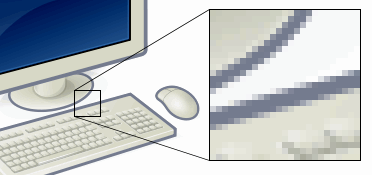
Back Pieksel Afrikaans بكسل Arabic Píxel AST Piksel Azerbaijani Піксель Byelorussian Піксэл BE-X-OLD Пиксел Bulgarian पिक्सेल Bihari পিক্সেল Bengali/Bangla Piksel BS

In digital imaging, a pixel (abbreviated px), pel,[1] or picture element[2] is the smallest addressable element in a raster image, or the smallest addressable element in a dot matrix display device. In most digital display devices, pixels are the smallest element that can be manipulated through software.
Each pixel is a sample of an original image; more samples typically provide more accurate representations of the original. The intensity of each pixel is variable. In color imaging systems, a color is typically represented by three or four component intensities such as red, green, and blue, or cyan, magenta, yellow, and black.
In some contexts (such as descriptions of camera sensors), pixel refers to a single scalar element of a multi-component representation (called a photosite in the camera sensor context, although sensel 'sensor element' is sometimes used),[3] while in yet other contexts (like MRI) it may refer to a set of component intensities for a spatial position.
Software on early consumer computers was necessarily rendered at a low resolution, with large pixels visible to the naked eye; graphics made under these limitations may be called pixel art, especially in reference to video games. Modern computers and displays, however, can easily render orders of magnitude more pixels than was previously possible, necessitating the use of large measurements like the megapixel (one million pixels).
- ^ Foley, J. D.; Van Dam, A. (1982). Fundamentals of Interactive Computer Graphics. Reading, MA: Addison-Wesley. ISBN 0201144689.
- ^ Rudolf F. Graf (1999). Modern Dictionary of Electronics. Oxford: Newnes. p. 569. ISBN 0-7506-4331-5.
- ^ Michael Goesele (2004). New Acquisition Techniques for Real Objects and Light Sources in Computer Graphics. Books on Demand. ISBN 3-8334-1489-8. Archived from the original on 2018-01-22.